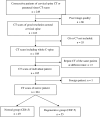The footprint mismatch of cervical disc arthroplasty comes from degenerative factor besides ethnic factor
- PMID: 39237767
- PMCID: PMC11377700
- DOI: 10.1038/s41598-024-71786-5
The footprint mismatch of cervical disc arthroplasty comes from degenerative factor besides ethnic factor
Abstract
A mismatch in footprints of cervical total disc arthroplasty (CTDA) implants occasionally occurred in Asian population and it had been attributed solely to ethnic factor. Yet, cervical degeneration process may play a role. Our purpose was to compare the cervical vertebra morphometric data with and without degeneration. The study included patients with CT scans of cervical spine from our hospital between January, 2019, and September, 2021. The total cervical degenerative index (TCDI) of each patient were collected by adding CDI score for 5 disc-levels. Patients were categorized into normal (TCDI 0-5) and degeneration groups (TCDI 6-60). Various measurements of the C3-C7 vertebral body and endplate were taken. Forty-nine patients in the normal group and 55 in the degeneration group were included. No significant difference was noted in gender, BH, BW, or BMI except age and TCDI (p < .001). During degeneration, disproportional endplate size changes were observed, with an increment ratio of 12-20% in the anteroposterior and 5-17% in the mediolateral plane throughout C3-C7, while vertebral body height remained constant. In conclusion, degeneration process, besides ethnic factor, causes the endplate size and shape mismatch. This information can help spine surgeon choose appropriate implants in CTDA surgery.
Keywords: Cervical degeneration index; Cervical spine; Degenerative change; Spinal anatomy; Total disc arthroplasty; Vertebral body.
© 2024. The Author(s).
Conflict of interest statement
The authors declare no competing interests.
Figures






Similar articles
-
Footprint mismatch in total cervical disc arthroplasty.Eur Spine J. 2013 Apr;22(4):759-65. doi: 10.1007/s00586-012-2594-3. Epub 2012 Nov 27. Eur Spine J. 2013. PMID: 23184184 Free PMC article.
-
Cervical kinematics and radiological changes after Discover artificial disc replacement versus fusion.Spine J. 2014 Jun 1;14(6):867-77. doi: 10.1016/j.spinee.2013.07.432. Epub 2013 Sep 26. Spine J. 2014. PMID: 24076441
-
Clinical and radiographic analysis of an artificial cervical disc: 7-year follow-up from the Prestige prospective randomized controlled clinical trial: Clinical article.J Neurosurg Spine. 2014 Oct;21(4):516-28. doi: 10.3171/2014.6.SPINE13996. Epub 2014 Jul 18. J Neurosurg Spine. 2014. PMID: 25036218 Clinical Trial.
-
Cervical Disc Arthroplasty: Review and Update for Radiologists.Semin Roentgenol. 2019 Apr;54(2):113-123. doi: 10.1053/j.ro.2018.06.001. Epub 2018 Jun 6. Semin Roentgenol. 2019. PMID: 31128736 Review. No abstract available.
-
Double-level cervical total disc replacement for adjacent segment disease: is it a useful treatment? Description of late onset heterotopic ossification and review of the literature.Eur Rev Med Pharmacol Sci. 2014;18(1 Suppl):15-23. Eur Rev Med Pharmacol Sci. 2014. PMID: 24825036 Review.
References
MeSH terms
LinkOut - more resources
Full Text Sources
Medical
Miscellaneous

